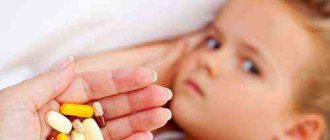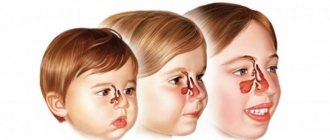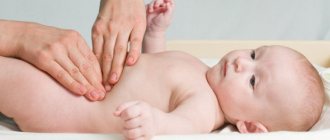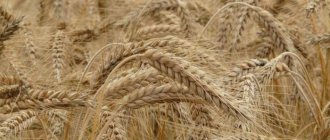More about pathology
Pancreatitis in children refers to autocatalytic enzymatic inflammatory-dystrophic lesions of the pancreas. This disease in children occurs in about 5-25% of cases among pathologies of the digestive tract.
Often manifestations of pancreatitis in a child are attacks of night nausea, abdominal pain and subsequent vomiting. These symptoms can last for about a day.
Symptoms of childhood pancreatitis are often similar to those of rotavirus infection, which can be confusing to many parents.
It is very important to recognize symptoms as early as possible and follow clinical recommendations to reduce the risk of complications. The child needs treatment or a change in nutrition to the “correct” one for a short time.
Doctors see a connection with the massive consumption of sweets, carbonated drinks, and chewing gum, which contain a lot of chemicals that can accumulate in the body, contributing to its slow poisoning.
In children, pancreatitis rarely becomes chronic. The acute process proceeds rapidly and ends with complete relief from the disease or death.
Prevention
Prevention of childhood pancreatitis includes basic rules. It is important to follow the diet (the menu must correspond to the age of the child). If a small patient is diagnosed with diseases of the digestive system, then they must be treated fully and in a timely manner. Uncontrolled use of medications and self-medication should not be allowed. Additionally, excessive physical and emotional stress should be avoided. A disturbance in the psychoemotional state can cause a number of digestive pathologies.
Video on the topic: Pancreatitis - effective treatment + diet. Treatment of the pancreas without drugs or with drugs.
Causes of pathology
The development of pancreatitis in children is due to the pathological influence of its own activated enzymes on the pancreas, which damage tissues, blood vessels, and excretory ducts of the gland.
Chronic inflammation in the vast majority of cases is secondary and is considered a consequence of acute pancreatitis.
The causes of pathology in children are:
- failure in the process of outflow of pancreatic secretions, which manifests itself in pathologies of development or obstruction of the excretory ducts of the pancreas, duodenum, and gallbladder;
- helminthiasis (ascariasis);
- blunt abdominal trauma;
- previous acute viral and bacterial infections (sepsis, salmonellosis, chicken pox, dysentery, mumps, herpes virus infection);
- against the background of gastrointestinal diseases (peptic ulcer, hepatitis, gastroduodenitis, cholelithiasis, cholecystitis);
- malignant tumors (pancreatic cancer).
A risk factor is the child’s poor nutrition—violation of the diet, consumption of large amounts of spicy, fatty foods, fast food, and carbonated drinks.
The appearance of pancreatitis in children can be caused by toxic-allergic reactions to taking certain types of medications - sulfonamides, corticosteroids, cytostatics and others, and eating foods. There are also some cases of pancreatitis where the cause of the disease is unknown, in this case idiopathic pancreatitis develops.
All risk factors can be divided into three groups:
- Toxic-allergic. In children, this group of factors comes first. This group includes poisoning - food poisoning, medication poisoning, the influence of toxins from various infectious agents.
- Stressful. Prolonged psychological overstrain and stress cause dysfunction of the nervous regulation of pancreatic activity. This leads to a failure of microcirculation in the organ, local circulatory disorders begin to occur - multiple small foci of necrosis are formed in the tissue, which later undergo inflammation.
- Mechanical. The pathology appears due to a failure in the process of outflow of secretions through the ducts due to the presence of an obstacle in its path. Usually the lumen is covered by stones (calculi), which are formed due to poor nutrition and the constant presence of fatty, high-carbohydrate dishes on the menu. As a result, the load on the pancreas increases, the secretion thickens, and later stones form, which interfere with the normal circulation of pancreatic juice.
Classification of the disease
In children, according to the nature of its course, pancreatitis is divided into acute and chronic.
Acute pancreatitis is characterized by: catarrhal inflammation and swelling of the pancreas; in severe cases, hemorrhage, tissue necrosis and toxemia occur.
In chronic pancreatitis, the inflammatory process occurs against the background of degenerative changes - fibrosis and atrophy of the pancreatic parenchyma and a gradual failure of its functionality, sclerosis. Schoolchildren are characterized by a chronic, often latent course of the disease; acute pathology is quite rare.
Depending on the clinical and morphological transformations, the following are distinguished:
- purulent pancreatitis;
- acute edematous (interstitial);
- fatty pancreatic necrosis;
- hemorrhagic.
Based on its origin, chronic pancreatitis is divided into:
- primary;
- secondary.
According to the flow form:
- recurrent;
- latent.
According to severity:
- easy;
- medium-heavy;
- heavy.
Recurrent pancreatitis has phases: exacerbation, subsidence of exacerbation and remission.
The latent form has no pronounced symptoms.
Reactive pancreatitis is formed as a response of the pancreas to various inflammations of the gastrointestinal tract, but it is reversible with timely treatment of the main pathology or turns into “true” pancreatitis, in combination with destruction of the gland. There is hereditary pancreatitis, transmitted by an autosomal dominant type.
Forms of pancreatitis
Pediatric pancreatitis can be acute, chronic or reactive in nature. Each form of the disease has its own characteristics of manifestation. The extent of damage to the pancreas varies. Different types of pancreatitis require different treatment regimens.
Only a specialist can determine the specific form of the inflammatory process based on a comprehensive examination of the child.
Spicy
Acute pancreatitis in children is characterized by swelling of the pancreas tissue. Complications of this pathology can manifest themselves in the form of necrosis and hemorrhage. The risk group includes children 10-13 years old. The main causes of the disease in this age category of patients are the consequences of food allergies and poor nutrition. Symptoms of pancreatitis manifest themselves in a pronounced form (sudden attacks).
Chronic
Chronic pancreatitis develops against the background of fibrosis, sclerosis or pancreatic parenchyma. The functions of the organ in this disease are gradually impaired. For the development of the inflammatory process, the presence of degenerative changes in the digestive system is necessary. Chronic DP can be primary or secondary. According to the course, the disease is divided into latent and recurrent forms. In the first case, the symptoms are mild, but regular. In the second, periods of exacerbation are replaced by remissions of varying durations.
Classification by severity:
- light form;
- moderate form;
- severe form.
Reactive pancreatitis in children
Reactive DP is a response of the pancreas to inflammatory processes in other digestive organs. This pathology becomes true pancreatitis only in the absence of adequate and timely therapy. Children aged 10-14 years are at risk.
The most common provoking factor of the disease is an infectious lesion of the digestive tract.
Symptoms
Symptoms of chronic pancreatitis depend on the duration, form and stage of the disease, the degree of failure of the functionality of the pancreas and other organs of the gastrointestinal tract. In the chronic course of the pathology, there may be periodic or constant aching pain in the epigastric area, which is aggravated by errors in nutrition, after emotional stress or physical activity. Painful attacks can last from several hours to several days.
May be observed:
- decreased appetite;
- nausea, vomiting;
- heartburn;
- weight loss;
- constipation that alternates with diarrhea;
- asthenovegetative syndrome.
In children with chronic pancreatitis, damage occurs that goes away over time, as with acute pancreatitis. In some children, inflammation continues and contributes to the appearance of permanent disturbances in the structure and activity of the pancreas.
The pain is diffuse throughout the abdomen, sometimes concentrated in the epigastric region. As in adults, girdle pain is not observed in children. The pain is severe, the child is capricious, cries, and takes a forced position. Symptoms appear suddenly or after eating harmful foods.
The following symptoms of intoxication are also characteristic:
- weakness;
- temperature rise to 38 C;
- dizziness;
- disturbances of consciousness.
In the acute period, the temperature reaches 39-40 C. This happens when infectious complications occur. The patient is disoriented, pale skin, severe sweating, and sometimes delirium and hallucinations appear.
The acute form of pancreatitis is characterized by severe inflammation that lasts a short period of time. In severe cases, this form leads to bleeding in the organ, tissue damage, infection and the appearance of cysts.
Reactive pancreatitis in children
This form of pancreatitis is slightly different from other forms of the disease. This type of pancreatitis is the body’s response to various adverse effects in the form of inflammation of the pancreas. The causes of this form of the disease are:
- Children's infectious diseases (sore throat, ARVI, etc.).
- Abdominal injury.
- Pathology of the digestive organs.
- Poisoning with chemical toxins.
- Taking strong antibiotics.
- Poor quality products, irregular meals.
Treatment prognosis
With a mild form of pancreatitis and timely treatment, the prognosis for children is favorable. Pathology can be eliminated forever if it is diagnosed in time and appropriate treatment measures are taken. Purulent inflammatory processes or complications can cause the death of a child.
Ignoring the disease can cause serious damage to the digestive tract.
Possible complications:
- false cyst;
- pleurisy;
- peritonitis;
- phlegmon;
- abscess;
- diabetes.
Differences between reactive and acute forms of the disease
Reasons for formation:
- for reactive type of pathology – pathology of other organs,
- for acute – direct toxic and damaging effects of various nature.
Consequences of lack of treatment:
- acute - does not become reactive;
- reactive - turns into an acute form.
When diagnosing reactive pancreatitis, symptoms of diseases of other organs are detected, but not necessarily in the acute form.
In addition to the above differences, there are similarities between these forms of the disease:
Diagnosis is performed using the same methods. Treatment is the same as for the acute form. Prevention methods are usually the same.
Diagnostics
Diagnosis is based on the clinical picture, the results of instrumental and laboratory studies. On palpation of the pancreas, positive symptoms of local pain are observed: Kach, Kerte, Mayo-Robson.
In the acute form, a general blood test reveals an increase in ESR, moderate or severe neutrophilic leukocytosis. In a biochemical blood test - an increase in the activity of pancreatic enzymes (trypsin, lipase, amylase), hyperglycemia.
A lipid profile and stool coprogram are also prescribed, as well as elastase-1 activity in the stool. The presence of steatorrhea and creatorrhoea in a child is considered a pathognomonic sign of the chronic course of the disease.
Biochemical analysis of urine shows an increase in the level of diastase by at least 5 times in acute pancreatitis.
Ultrasound can detect organ enlargement, the presence of areas of necrosis, heterogeneity and compaction of the parenchyma.
Survey radiography shows transformations in the organs of the digestive tract and the presence of stones. If necessary, MRI and CT scans of the abdominal cavity are performed.
Diagnosis of reactive pancreatitis involves performing an amylase and lipase test (blood test) to determine the level of enzymes in the organ.
Differential diagnosis is carried out with acute intestinal obstruction, acute cholecystitis, biliary or renal colic, gastric and duodenal ulcers, acute appendicitis.
How to treat pancreatitis
When the patient is in a stable condition, therapy always begins with conservative treatment.
Treatment of the acute phase of pancreatitis is carried out in a hospital with bed rest and fasting for several days. Alkaline mineral water is taken, parenteral administration of glucose solution is carried out, according to indications - inhibitors of proteolytic enzymes, plasma, hemodesis. For pancreatitis, a diet is prescribed that does not stimulate pancreatic secretion and provides mechanical and chemical sparing of the digestive tract.
To combat pain, analgesics and antispasmodics are prescribed. To ensure metabolic stability, antisecretory drugs (Famotidine, Ranitidine) are added to therapy. For stomach problems, Omez or Omeprazole is prescribed.
In case of complications, Trasylol is indicated. It affects the pancreas itself, completely blocking its functional activity.
Infusion therapy is prescribed to all patients, especially with hypovolemia (low blood pressure) and in shock.
Antibiotic therapy is mandatory in the presence of infection and to prevent infectious complications
Comprehensive treatment includes corticosteroids and antihistamines - they reduce inflammation.
If conservative treatment is ineffective and the pathological process progresses, as well as if complications occur, surgical treatment is prescribed. The goal of the surgery is to remove dead areas of the gland while preserving as much healthy tissue as possible. During the recovery period, lifelong enzyme replacement therapy (Pancreatin tablets and its analogues) is indicated.
Treatment of the reactive form consists of three parts - diet therapy, treatment of the underlying disease, treatment of pancreatitis. On days 1-2, it is recommended not to feed the child at all, only drinking water is allowed. The menu is expanding very slowly. For the first two weeks, pureed food is recommended. To make the feeding process easier, it is better to create a sample menu for the week.
Treatment methods
Therapy for DP includes medications, conservative methods and surgery. If the diagnosis is confirmed, the child should be treated in a hospital under the supervision of doctors. The duration of hospitalization depends on the degree of damage to the digestive system. After discharge, parents are given recommendations, compliance with which will help prevent repeated attacks of the inflammatory process. Some alternative medicines are allowed to be used as an addition to primary therapy.
Conservative treatment
The goal of conservative treatment of DP is to provide the affected organ with functional rest, relieve symptoms of inflammation and eliminate the causes of its occurrence. During the therapy period, measures are taken to prevent chemical or mechanical effects on the digestive tract. On the first day, the child is recommended to take a “food break” (fasting for two to three days). It is allowed to drink alkaline mineral waters without gas. Nutrition begins on the third day with gentle foods and small portions.
Nutrition for pancreatitis
In the first days of the acute phase of the pathology, fasting is recommended. Later they switch to a gentle diet.
Vegetables: allowed in any quantity. Excluded from the menu: radish, horseradish, radish, garlic, ginger.
Fruits: you can have baked apples and pears. The consumption of other fruits is limited. Citrus fruits are being removed from the menu.
Meat: You can eat low-fat varieties - turkey, chicken, rabbit, boiled or steamed veal.
All types of mushrooms, nuts, and spices are excluded from the menu.
Fermented milk products are allowed - fermented baked milk, kefir, cottage cheese.
Bread - only in dried form.
Drinks: jelly, herbal decoctions, compotes, teas - in unlimited quantities. You should completely give up alcoholic and carbonated drinks, kvass.
Sample menu
For breakfast:
- a slice of wheat toast;
- 2 eggs (whites only) with spinach;
- tea.
For second breakfast:
- apple;
- herbal tea.
For lunch:
- 100 g chicken breast;
- red or black beans, rice;
- cake;
- juice or water.
For afternoon tea:
- banana;
- crackers;
- water.
For dinner:
- shrimp pasta;
- a small portion of green salad with balsamic vinegar or low-fat dressing;
- juice or water.
For the night:
- low-fat Greek yogurt with honey and blueberries;
- herbal tea or water.
If you have celiac disease, diabetes, lactose intolerance or other health problems, changes in diet are needed.
Diet food
Any disease of the pancreas requires a change in the patient’s usual lifestyle and diet. Diet for pancreatitis in children is an important component of therapy. Dietary nutrition should correspond to the patient’s age and the severity of the pathology. It allows you to eliminate some of the symptoms of pancreatitis in children and will promote the regeneration of the digestive gland.
In case of exacerbation of the disease, it is necessary to exclude feeding for 2 days. It is only allowed to drink mineral water without gas. Nutrients are administered to the child parenterally (glucose, blood plasma, albumin). On days 3-4, it is allowed to introduce non-acidic fruit juices, fruit drinks, weak tea, and rosehip decoction into the menu. During the day you are allowed to drink up to 1.5 liters of liquid.
On day 5, you can introduce proteins into your diet. Salt should not be used during cooking. All products must have a puree-like consistency. If you feel better on days 6-7, you are allowed to increase the caloric content of food by adding fats. It is important to divide the daily diet into 6 small meals. Food should be at moderate temperature.
List of prohibited products:
- Legumes;
- Fatty fish and meats;
- Smoked, fried, sour, too salty, spicy dishes;
- Carbonated and alcoholic drinks;
- Cabbage in any form;
- Sweets;
- Rich broths;
- Baked goods and fresh bread;
- Fresh vegetables and fruits.
The following diet is widely used for children:
- Breakfast. Oatmeal, semolina or rice porridge in water with the addition of baked fruits;
- Lunch. Juice or jelly with shortbread cookies;
- Dinner. Puree soups based on carrots, potatoes, beets, rice or buckwheat;
- Afternoon snack. Cottage cheese casseroles or puddings;
- Dinner. Boiled fish or cutlets, souffle, meatballs from lean meat (rabbit, chicken, veal, turkey) with mashed potatoes, zucchini or carrots;
- Second dinner. In the evening you are allowed to drink 250 ml of low-fat kefir or yogurt without fruit filling.
We also recommend viewing: Features of diet No. 5 for pancreatitis










